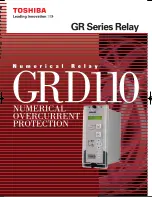
Instruction
Leaflet
I.L.
ABB Power T&D Company Inc.
Relay Division
Coral Springs, FL 33065
RCL
Effective: February 1966
Supersedes
I.L
41-661.2
Dated May 1984
Automatic ReclosingRelay
Q
Denotes Change From Superseded
issue
in
FT-21 Case
CAUTION
Before putting relays into service, remove all
blocking which may have been inserted for the
purpose of securing the parts during shipment,
make sure that all moving parts operate freely,
inspect the contacts to see that they are clean and
close properly, and operate the relay to check
the settings and electrical connections.
APPLICATION
The type RCL automatic reclosing relay is used
for automatic reclosure of a-c or d-c electrically
operated circuit breakers after they have been
opened by overcurrent or other protective relay
action. The relay may be adjusted to provide
several reclosures at predetermined time inter-
vals, so that in case the breaker does not remain
closed after the first reclosure additional reclo-
sures will be made. The first reclosure usually
is an instantaneous reclosure through preclosed
contacts since system operating experience has
shown that the majority of faults are of a tem-
porary nature, such as lightning flashovers, and
will not be re-established after interruption of the
fault current. Consequently, service interruption
can be minimized by the use of an instantaneous
reclosure. However, the first reclosure may be
delayed if desired.
In case the circuit breaker does not remain
closed after the first reclosure, the relay will make
additional reclosures at suitably graded intervals.
It is common practice to make two additional
reclosures, but the relay may be adjusted to make
any number up to a total of six reclosures if de-
sired. If the breaker does not remain closed after
the final reclosure, the timing drum stops in the
“Lockout” position, and any further attempts at
reclosure must be made by manual operation of
the control switch. However, if the breaker re-
mains closed after any automatic reclosure, or,
subsequently, after manual reclosure, the relay
timing drum will advance to and stop at the
“Start” position, where the relay is in readiness
for another cycle of automatic reclosures follow-
ing the next tripping of the breaker.
For any automatic reclosing application, the
de-rating factors for breaker interrupting ability
should be checked when choos&g any particular
reclosing cycle. Also, when using instantaneous
first reclosure it is necessary that the protective
relays open their contacts within 10 cycles or
less after the breaker is tripped in order that the
trip circuit will be de-energized before reclosure
takes place.
CONSTRUCTION
As shown in Fig. 2, the RCL relay consists of a
Olatching solenoid unit, Y, a synchronous motor
driven timing unit, and a telephone relay unit, X.
TIMING UNIT
The timing unit contains a synchronous motor
and gear train mounted behind the front subbase.
The gear train drives a drum with cams, which
actuate contacts 1, 2 3, 4 and 14. Cam #5
actuates the Y unit latch to reset the Y unit and
close the Y 13 contact. Cams # 1 and #2, which
operate contacts 1 and 2 respectively, are notched
and are not intended to be adjusted in the field.
Cam #3 is a series of flat springs secured by
screws, which can be located at any point on the
All possible contingencies which
may
arise during installation, operation or maintenance, and all details
and variations of this equipment do not purport to be covered by these instructions. If further information
is desired
by
purchaser regarding #is particular installation, operation or maintenance of this equipment,
the local ABB Power T&D Company Inc. representative should be contacted.
Printed in
USA






























